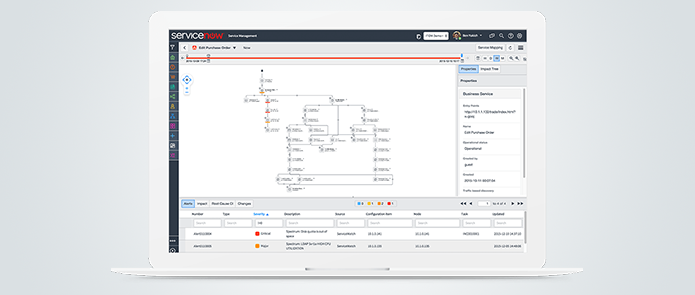Mapping interdependencies in complex IT landscapes

As we explained in an earlier blog post, operating an enterprise IT-landscape is far more complex than 5 or 10 years ago. Gone are the times the IT was the only department delivering IT to the business.
Nowadays a large part of the IT and IT services are bought and delivered by other departments. SaaS and PaaS solutions intertwined with on-premise IT have created new types of interdependencies that can be difficult to keep track, being effectively out of view of IT operations. This poses a risk to business continuity.
As dependency on IT increases, so does its complexity while control over the IT landscape decreases. These three issues should be tackled simultaneously. When it comes to IT, speeding up the business depends on a clear overview of all assets in the IT-landscape, knowing which interdependencies there are and what risk of outages those interdependencies bring along with them. The consequences these changes may have for the business as a whole need to be obvious to both the engineer and the CIO.
A holistic approach to ITOM
Traditionally, IT services are categorized in hierarchies, with main and subservices, much like Linnaeus has mapped the natural world. IT departments were subdivided based on technology. Engineers were responsible for their part of the hierarchy, for example switching and routing, remote desktop, databases, SAP, storage and virtualization.
Modern IT landscapes are holistic and specialist skill sets are required to maintain services. Customers or ‘the business’ want a specific solution to a problem which may involve multiple IT-assets. Because of this, seemingly minor services can have a major impact. Classic configuration management, even when supported by modern discovery tooling, isn’t sufficient, since interdependencies remain unknown and have to be mapped manually. In many companies this mapping is done outside the core ITSM process. Aris, ArchiMate and Visio are core products for architects to document services, but have limited value for the engineer and the CIO and are often outdated when they are completed. Moreover, these methods are error prone and rely heavily on knowledge and a commitment individual employees may or may not have.
Mapping services thoroughly is essential to gain a solid grip on IT operations management (ITOM). What’s more, the engineer responsible for specific systems and applications must be able to gain an understanding of the IT services that is relevant to his tasks and responsibilities. For example, when implementing changes to servers, he needs to know which business services could be affected. Simultaneously the CIO, who has an abstract view on the IT service landscape, needs to know how his decisions can impact operations and what he has to ask his engineers to ensure continuity is guaranteed. And, of course, how he can invest the scare IT budget wisely.
Peeling off layers of complexity
The approach to improve IT operations with ServiceNow ITOM is like peeling an onion. By combining intelligent tooling with a steady but gradual approach, clear insight is gained in how IT components are used in delivering services. For this we have created a reference model to map business services. This approach fits in the DevOps approach Plat4mation advocates but also fits more classical IT organizations. It will help companies to proceed mapping business services in a way that makes sense. Although everything in IT is connected, our approach is not to create complex maps, but to create understandable logical blocks which we combine to ServiceMaps. It bridges the gap between what a user uses and what IT delivers. The end result will be a single truth in ServiceNow where you can choose how to look at the same environment from different perspectives.
The database support team or any other specialist will have a clear overview of their work and can easily see how their activities impact the big picture. Service managers can see the performance of their service but also the service a user experiences.
When such a clear overview is available, it can be enriched. Teams are no longer working in isolation and management is no longer operating in the blind. Now it makes sense to integrate ServiceNow with monitoring tools so the actual status of a service becomes visible. The alerts generated by this monitoring will be translated to actionable events. From there on, resolution can also be automated.
Mapping IT that supports business services is not easy, even with the advanced discovery tooling of ServiceNow. It has to be done step by step, IT and business services need to be thoroughly validated and switching from a hierarchical to a holistic vision on IT isn’t done in a few days. Organizations that see the need to map their IT-landscape and want to do it right therefore often rely on partners that have proven experience and understand that transparency is key to successfully bring ITOM to the next level.
Join 1400+ ServiceNow professionals
Sign up to our monthly Flow@Work Exclusive newsletter to get free access to our expertise and lots of tips and tricks to make work flow on the Now® Platform.



 Geert-Jan Slot
Geert-Jan Slot